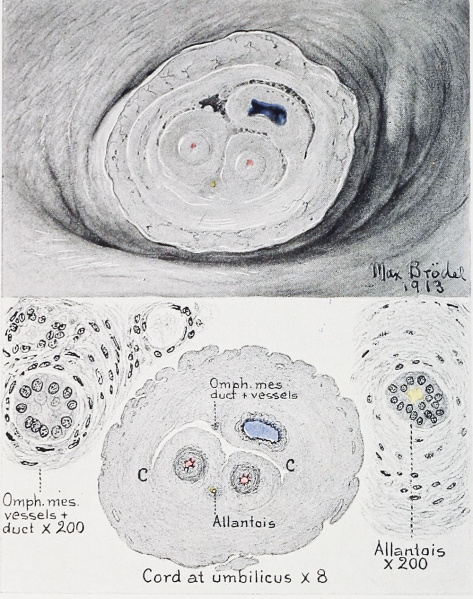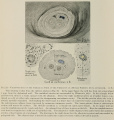File:Cullen1916 fig23.jpg

Original file (1,000 × 1,266 pixels, file size: 346 KB, MIME type: image/jpeg)
Fig. 23. Cross-section of the Umbilical Cord at the Umbilicus in a Human Embryo 12 cm in Length
(X 8.)
This drawing is also from the embryo shown in Fig. 22 In the upper figure the cord has been cut across about 1 mm from the abdominal wall. The umbilical arteries are surrounded by Wharton's jelly. In the triangle below and between them is a small, opaque cord, the allantois. Above the right umbilical artery an irregular lumen, continued as a slit on either side, represents the disappearing exocoelomic cavity. The slit-like portion above the vein is already partially organized. Surrounding the entire mass is a dense layer of connective tissue, and external to this is the subcutaneous adipose tissue traversed by numerous cutaneous vessels. The lower picture shows a microscopic section still nearer the embryo. The slit-like exocoelom (c, c) stands out much more clearly. In its upper wall are seen the omphalomesenteric vessels and duct. An enlarged view of these is given on the left. Here the omphalomesenteric duct is recognized as a solid nest of epithelial cells. The allantois is visible slightly below and between the umbilical arteries, whose lumina are star-shaped.
The drawing to the right shows that the allantois is patent and surrounded by polygonal cells. The allantois here is inclosed in embryonic connective tissue which is devoid of muscle.
| Historic Disclaimer - information about historic embryology pages |
|---|
| Pages where the terms "Historic" (textbooks, papers, people, recommendations) appear on this site, and sections within pages where this disclaimer appears, indicate that the content and scientific understanding are specific to the time of publication. This means that while some scientific descriptions are still accurate, the terminology and interpretation of the developmental mechanisms reflect the understanding at the time of original publication and those of the preceding periods, these terms, interpretations and recommendations may not reflect our current scientific understanding. (More? Embryology History | Historic Embryology Papers) |
- Figure Links: 1 Human embryo 0.7 mm | 2 Human embryo 1.7 mm | 3 Human embryo 2.5 mm | 4 Human embryo 3.5 mm | 5 Human embryo 5 mm | 6 Human embryo 7 mm | 7 Human embryo 7 mm | 8 Human embryo 10 mm | 9 Human embryo 12.5 mm | 10 Human embryo 10 mm | 11 Human embryo 23 mm | 12 Human embryo 3 cm | 13 Human embryo 4.5 cm sagittal | 14 Human Embryo 4.5 cm | 15 Human Embryo 5.2 cm | 16 Human Embryo 6.5 cm | 17 Human Embryo 7.5 cm | 18 Human Embryo 9 cm | 19 Human Embryo 10 cm | 20 Human Embryo 12 cm | 21 Human Embryo 12 cm | 22 Human Embryo 12 cm | 23 Human Embryo 12 cm Cord | 28 Fetus Five Months | 30 Ventral Heria | 31 Human Embryo 5.5 cm | 32 Term Human | 33 Term Human | [[Figures
Reference
Cullen TS. Embryology, anatomy, and diseases of the umbilicus together with diseases of the urachus. (1916) W. B. Saunders Company, Philadelphia And London.
Cite this page: Hill, M.A. (2024, April 24) Embryology Cullen1916 fig23.jpg. Retrieved from https://embryology.med.unsw.edu.au/embryology/index.php/File:Cullen1916_fig23.jpg
- © Dr Mark Hill 2024, UNSW Embryology ISBN: 978 0 7334 2609 4 - UNSW CRICOS Provider Code No. 00098G
File history
Click on a date/time to view the file as it appeared at that time.
| Date/Time | Thumbnail | Dimensions | User | Comment | |
|---|---|---|---|---|---|
| current | 20:48, 28 October 2018 |  | 1,000 × 1,266 (346 KB) | Z8600021 (talk | contribs) | |
| 20:46, 28 October 2018 |  | 2,034 × 2,149 (917 KB) | Z8600021 (talk | contribs) |
You cannot overwrite this file.
File usage
The following 3 pages use this file:
